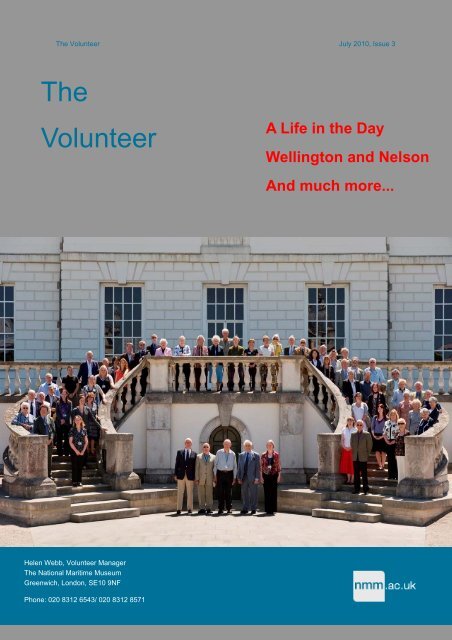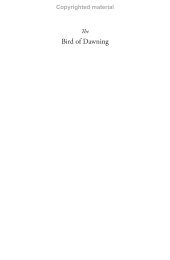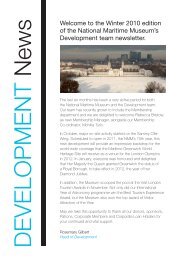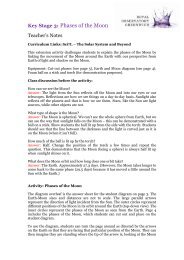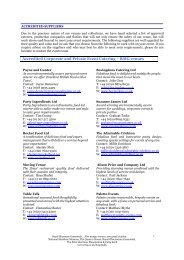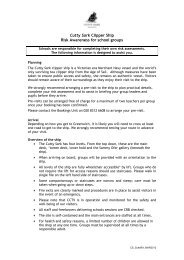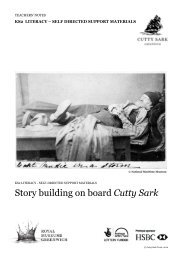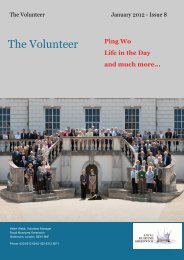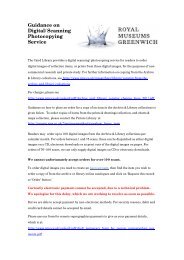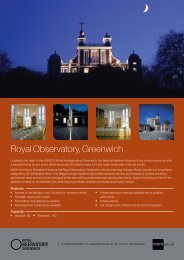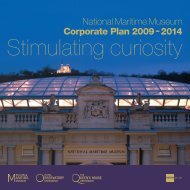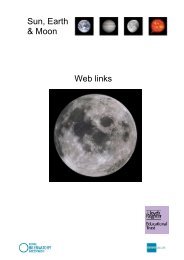New look volunteer newsletter july 10.pub - National Maritime Museum
New look volunteer newsletter july 10.pub - National Maritime Museum
New look volunteer newsletter july 10.pub - National Maritime Museum
You also want an ePaper? Increase the reach of your titles
YUMPU automatically turns print PDFs into web optimized ePapers that Google loves.
The Volunteer July 2010, Issue 3<br />
The<br />
Volunteer<br />
A Life in the Day<br />
Wellington and Nelson<br />
And much more...<br />
Helen Webb, Volunteer Manager<br />
The <strong>National</strong> <strong>Maritime</strong> <strong>Museum</strong><br />
Greenwich, London, SE10 9NF<br />
1<br />
Phone: 020 8312 6543/ 020 8312 8571
The Volunteer July 2010, Issue 3<br />
Editorial by Helen Webb:<br />
Welcome to this new-<strong>look</strong> 3rd issue of<br />
your <strong>newsletter</strong> with the usual mix of articles<br />
and pictures. We hope you’ll be inspired<br />
to send in your contributions: the<br />
more the merrier! Comments on our new<br />
<strong>look</strong>, which we’ve created ourselves in<br />
the office, are also welcomed.<br />
We include an article on our very successful,<br />
and first, Volunteers Seminar<br />
and Lunch which was held in early June.<br />
The day included a group photograph<br />
(reproduced on our front cover). Hard<br />
copies, presented in a smart black<br />
mount, can be bought for £5.30 from the<br />
Volunteers Office.<br />
Since our last issue we’ve had some staff<br />
changes. John Hogg, our Volunteer Coordinator,<br />
left last month when the external<br />
funding for his post expired. We<br />
wish him every success in the future,<br />
and thank him for all his hard work. We<br />
now have a Gallery Assistant called<br />
Vicky Weaver on secondment. Both<br />
Vicky and I are happy to answer any<br />
questions, and to help you in any way we<br />
can. The <strong>Museum</strong> is currently advertising<br />
for a number of <strong>volunteer</strong> roles and if<br />
you’ve any friends who’d be interested in<br />
joining please direct them to our website.<br />
In particular we’re seeking Queen’s<br />
House Room Guides. Those considering<br />
applying for this role can learn more at<br />
one of our Open Days. The next two will<br />
be held in the Queen’s House between<br />
11.00 & 15.00 on Wednesday 4 August<br />
and Saturday 11 September. All are welcome.<br />
On a more domestic level, we need to<br />
draw your attention to the acute shortage<br />
of car parking spaces on the main museum<br />
site. Work on the Sammy Ofer<br />
Wing has reduced capacity on weekdays.<br />
Currently 150 passes have been issued<br />
for a car park which only holds 100 cars.<br />
This may appear unusual but it works<br />
because of the shift patterns that staff<br />
work over 7 days. The car park frequently<br />
operates at full capacity and this<br />
is why no more passes are available.<br />
However <strong>volunteer</strong>s coming in on bank<br />
holidays and weekends should speak to<br />
the Volunteers Office. On these days the<br />
car park operates as a pay-and-display<br />
for the public and passes might be available.<br />
We feel sure you’ll understand our<br />
position on this.<br />
And finally we present a summary of the<br />
Volunteer Programme as at June 2010.<br />
Volunteers help us out in every Division<br />
of the <strong>Museum</strong> as follows. Thank you as<br />
always for everything you do for us.<br />
Directorate (3): Director’s office, Press<br />
Office, Membership Office<br />
Collections (15): Paper & Textile Conservation<br />
Studios<br />
Research & Planning (35): Navy Board<br />
papers, Uncatalogued pamphlets, Sea<br />
Charts catalogue, <strong>Museum</strong> & Archive Records<br />
Centre, Brass Foundry, Fred Olsen<br />
Line catalogue<br />
Exhibitions & Programmes (20): Family<br />
Programme, Public Programme, Envelope<br />
Team<br />
Finance & Enterprise (3): Retail support,<br />
Picture Library, Photographic Studio<br />
Royal Observatory (23): Talks / Office /<br />
Horology, Flamsteed Society<br />
Operations & Human Resources (17):<br />
Family Ambassador, Interactive Gallery,<br />
Escorted tours, Travel Survey, Health &<br />
Safety<br />
<strong>National</strong> Historic Ships (2): Office support<br />
2
The Volunteer July 2010, Issue 3<br />
A Life in the Day of Anna Rolls, Scientific<br />
Instrument Conservator<br />
3<br />
“Conservation is archaeology but without the mud”<br />
Apparently, if you’re stuck on a boat in the middle<br />
of nowhere, then you would want to be with Anna<br />
Rolls, our next “Life in the Day of” interviewee.<br />
Here she talks to Vicky Weaver:<br />
Who are you, and what do you do?<br />
I’m Anna Rolls, the Scientific Instruments Conservator,<br />
which is quite a new role. Essentially I work with<br />
the metals conservation team and in horology, helping<br />
conserve, maintain and sometimes restore scientific<br />
items in the collection. I get objects ready for exhibitions,<br />
condition check items prior to storage and work<br />
towards improving the<br />
condition of the collection<br />
in the stores. Oh,<br />
and I also wind clocks<br />
one day a week!<br />
So, presumably that<br />
means you always<br />
know the right time?<br />
You would have<br />
thought so, but I still<br />
sometimes manage to<br />
be late for things!<br />
So what does clockwinding<br />
entail, if it’s<br />
not a silly question?<br />
There are 35 to 40<br />
clocks around the site,<br />
taking a whole day to<br />
wind up. It’s not just<br />
about using a key to wind the clocks. You want to<br />
determine the error in the clocks, which can help you<br />
tell whether the clock is running OK, and sometimes<br />
you need to re-set a clock, which means stopping it.<br />
I’m often asked by people “what are you doing?”. I<br />
think that most people don’t really appreciate that<br />
these are mechanical clocks and, considering that<br />
some of them are over 200 years old, they are incredibly<br />
accurate: most are accurate to within a few seconds,<br />
and one is kept accurate to within half a second.<br />
So, if you want to know the correct time, go to the<br />
Shepherd Gate Clock outside the front of the Observatory!<br />
What does your typical day consist of (when<br />
you’re not winding clocks)?<br />
The great thing about my job is that I don’t have a<br />
typical day. When I’m working in the metal conservation<br />
studio I can spend hours removing dirt off an object,<br />
which is always a satisfying feeling. In conservation<br />
you don’t set out to make an object <strong>look</strong> brand<br />
new, but you want to get to the stage where it can age<br />
gracefully; the aim is for it to <strong>look</strong> like we haven’t<br />
worked on it.<br />
Do you have a favourite piece in the <strong>Museum</strong>?<br />
I’m not the sort of person to have favourites. For me<br />
it’s more about the collection as a whole. I love going<br />
into the stores; it’s like an Aladdin’s Cave in there! I<br />
also love some of the regulators: they’re so beautifully<br />
made and precise, but not showy. Things interest me<br />
at different times; I’ll love one thing for its aesthetic<br />
qualities, and something else for its engineering or<br />
craftsmanship.<br />
What’s the best thing about your job?<br />
Working directly with the collection. These objects are<br />
a direct connection with history and so it’s a real privilege<br />
working with them. Also, I learn something new<br />
every day and each day is different from the next.<br />
Moving away from work, how do you relax?<br />
I enjoy cooking; I’ve recently started baking cakes,<br />
though I find it hard not to eat them! I also enjoy<br />
dancing.<br />
What did you want to be when you grew up?<br />
I wanted to be everything! I remember particularly<br />
wanting to be a vet; I grew up with All Creatures<br />
Great and Small and wanted to be James<br />
Herriot! I also wanted to be an archaeologist. I<br />
liked the idea of finding treasure, but not of getting<br />
wet and muddy. That’s the great thing<br />
about conservation: it’s like archaeology, but<br />
without the mud!<br />
If you weren’t at work, where would you be?<br />
In Suffolk with my boyfriend. I manage to get<br />
out of London most weekends; expensive, but<br />
worth it!<br />
What are you working on at the moment?<br />
At the moment the top priority is working on a range of<br />
silver ship models for display at Chatham. I’m also<br />
working my way through some sextants in the store,<br />
conserving them where appropriate.<br />
So, does your work on all these instruments mean<br />
that you know how they all work?<br />
Not all of them. Certainly the ones that need to be<br />
taken apart I make sure I know what they are and how<br />
they work. With something like the sextants though, I<br />
think if I was stuck on a boat in the middle of nowhere<br />
I’d probably be able to navigate myself somewhere!<br />
Is there a piece in the collection you would love to<br />
work with?<br />
The pieces that I most admire I would be really<br />
daunted to work on. With the work that’s being done<br />
on Harrison’s H2 at the moment, I would be terrified of<br />
breaking it! I love getting objects back to an aesthetic,<br />
if not a functioning, condition, and people often don’t<br />
realise that lots of the stuff in museums’ stores are not<br />
in pristine condition, and need a lot of work doing to<br />
them. That’s where I, and the other conservators,<br />
come in.
The Volunteer July 2010, Issue 3<br />
Meet … Tarah Butler<br />
Age: 21<br />
106 people gifting 15,000 hours in 2009.<br />
1 amazing achievement. Welcome to the<br />
<strong>National</strong> <strong>Maritime</strong> <strong>Museum</strong>’s Volunteer<br />
Programme.<br />
Thursday 3 June 2010 saw the NMM celebrate<br />
its <strong>volunteer</strong>s’ contributions as part of <strong>National</strong><br />
Volunteering Week. Volunteers from all over the<br />
<strong>Museum</strong> were invited to join the management<br />
team and the Director, Kevin Fewster, for a<br />
morning of events and lunch in the Great Hall,<br />
Queen’s House.<br />
Volunteers were given a series of presentations<br />
enlightening them to projects and developments<br />
museum-wide, gaining them a rare glimpse at<br />
the <strong>Museum</strong>’s agenda.<br />
The day was brilliantly organised and all that<br />
attended enjoyed getting to meet such a variety<br />
of people from all backgrounds. Kevin Fewster<br />
hopes this will be the first annual <strong>volunteer</strong>s<br />
event and I’m told that the feedback received<br />
since the event has been extremely encouraging.<br />
Kevin first realised the value of <strong>volunteer</strong>s in the<br />
museum environment whilst working in maritime<br />
museums in Australia, and particularly when he<br />
was the Director of the Australian <strong>National</strong> <strong>Maritime</strong><br />
<strong>Museum</strong>. I was fortunate enough to question<br />
him further:<br />
“I fast came to appreciate the tremendous contribution<br />
that <strong>volunteer</strong>s could make,” Kevin explained.<br />
“The tasks that they do expands the<br />
sheer amount of work that the museum is able to<br />
undertake, and the very presence of <strong>volunteer</strong>s<br />
within the museum helps build links between the<br />
museum and its wider community.”<br />
Favourite Item in the <strong>Museum</strong>: The Flotation<br />
Tank.<br />
Tarah is studying History at the University of Essex,<br />
Colchester. She <strong>volunteer</strong>s at the <strong>Museum</strong><br />
assisting children’s workshop activities and<br />
would do so more often if she didn’t have the<br />
busy student lifestyle. She talks about her experience<br />
here so far:<br />
“I <strong>volunteer</strong>ed at the <strong>Museum</strong> to get an insight<br />
into educational programmes and valuable work<br />
experience. I have gained invaluable experience<br />
in working with children and families, and working<br />
with such a large range of people is one of<br />
the aspects of <strong>volunteer</strong>ing that I enjoy the<br />
most.”<br />
Meet … Blanche Sears<br />
Age: “A golden age”<br />
Favourite item in the <strong>Museum</strong>: Nelson’s coats<br />
Blanche, one of our ‘golden girls’ here at the <strong>Museum</strong>,<br />
has followed an interesting path in her<br />
time as a <strong>volunteer</strong>. She belongs to NADFAS<br />
(the <strong>National</strong> Association of Decorative and Fine<br />
Arts Societies) and joined the NMM team when<br />
NADFAS were asked for <strong>volunteer</strong>s to assist the<br />
Paper Conservation Department. She started<br />
her time here working with over 2000 letters written<br />
by Nelson. She works on opening, preserving<br />
and logging historical maritime-based letters.<br />
Blanche finds herself being easily “taken back in<br />
time” and getting to know the subjects of her letters<br />
and their families. Blanche really enjoys <strong>volunteer</strong>ing<br />
and is pleased that “age is no barrier”<br />
and that she truly “feels valued”.<br />
Bryony Chinnery, Press Office <strong>volunteer</strong><br />
With the continued hard work of Kevin and his<br />
team, plus the NMM’s Volunteer Manager Helen<br />
Webb, the programme <strong>look</strong>s set to expand and<br />
grow, hopefully leading to an extensive, welcoming<br />
<strong>volunteer</strong>ing community within the <strong>Museum</strong>.<br />
It is occasions like this that make you wonder,<br />
who are the people <strong>volunteer</strong>ing their time at the<br />
<strong>Museum</strong>, and what do they do? I am very<br />
pleased to introduce you to a couple of our dedicated<br />
<strong>volunteer</strong>s:<br />
4
The Volunteer July 2010, Issue 3<br />
In our first issue John Hogg contributed a<br />
riddle called “Cooking the Books”. Readers<br />
who remember this piece will have realised<br />
that this cash counting conundrum was one<br />
of these infuriating riddles with no easy solution.<br />
Here John offers 2 discussion topics for<br />
you to ponder, and we’d love to hear your<br />
reactions:<br />
What do you think? Do you know anything<br />
from your own research that may throw<br />
some light on this matter?<br />
Discuss, Debate, Enjoy.<br />
Did Admiral Horatio Nelson and Arthur<br />
Wellesley, Duke of Wellington<br />
actually ever meet?<br />
• Historians have for many years<br />
searched for absolute proof that such a<br />
meeting occurred but are yet to find it.<br />
• In an office in the Foreign and Commonwealth<br />
Office building in Whitehall<br />
stands a Georgian fireplace. This fireplace<br />
is recorded as having been removed during<br />
a refurbishment from the former office<br />
of Lord Castlereagh, then Secretary of<br />
State for War and the Colonies, in Downing<br />
Street, to its current location at the<br />
FCO.<br />
• Above the mantelpiece of the fireplace,<br />
secured to the chimney breast wall,<br />
is an engraving, after the Victorian artist J.<br />
P. Knight. The engraving depicts two men<br />
who are standing at either end of the fireplace<br />
and there is a bottle and two glasses<br />
resting on the mantelpiece.<br />
• One of the figures is undoubtedly<br />
Nelson, and the other Wellington.<br />
• The fireplace in the sketch is an excellent<br />
depiction of the fireplace which now<br />
stands in the Foreign and Commonwealth<br />
Office.<br />
Of course this is inconclusive evidence that<br />
these two men enjoyed a drink in Downing<br />
Street together. The artist could have<br />
formed the sketch from memory; though a<br />
written testimony from him, which is also<br />
secured to the fireplace wall, claims he witnessed<br />
the event.<br />
Ship or boat?<br />
A <strong>volunteer</strong> on a training course recently<br />
asked her tutor “What is the difference between<br />
a ship and a boat?”. The instructor’s<br />
reply was “Well a boat is a vessel which is<br />
small enough to be carried on a ship”. Ah!<br />
But…<br />
During the Falklands conflict two Royal Fleet<br />
Auxiliary vessels the Sir Galahad and the Sir<br />
Tristram were attacked by missiles fired<br />
from Argentinean jets. Sadly there was a<br />
great loss of life and the vessels were both<br />
severely damaged. Sir Galahad was so<br />
badly damaged that she was eventually<br />
scuttled (a new vessel of that name was<br />
later built). Sir Tristram was loaded onto a<br />
ship and carried to the UK where she was<br />
repaired, re-fitted and returned to service.<br />
The Royal Fleet Auxiliary vessels of the<br />
Round Table Class were affectionately referred<br />
to by RFA crew members as the Sir<br />
Boats. There were 5 of them: the Sirs Galahad,<br />
Tristram, Geraint, Percival and Bedivere.<br />
They were capable of carrying a<br />
minimum of 200 troops, had their own<br />
cranes and derricks, carried lifeboats, and<br />
were capable of landing and carrying helicopters.<br />
Were they ships or boats?<br />
5
The Volunteer July 2010, Issue 3<br />
Cargoes<br />
Quinquireme of Nineveh from distant Ophir,<br />
Rowing home to haven in sunny Palestine,<br />
With a cargo of ivory,<br />
And apes and peacocks,<br />
Sandalwood, cedarwood, and sweet white wine.<br />
We plan to publish a poem in every future issue. We<br />
expect you have a vast number for us to choose<br />
from—do let us know. Above is a classic to start us<br />
off.<br />
Pun Corner<br />
This issue, instead of puns, we’ve been sent a word<br />
puzzle as follows:<br />
Stately Spanish galleon coming from the Isthmus,<br />
Dipping through the Tropics by the palm-green<br />
shores,<br />
With a cargo of diamonds,<br />
Emeralds, amethysts,<br />
Topazes, and cinnamon, and gold moidores.<br />
How is that the word FISH can be spelt GHOTI?<br />
GH is pronounced “F” as in “enough”.<br />
O is pronounced “I” as in “women”<br />
TI is pronounced “SH” as in “nation”.<br />
Can you send in any more like this? Or perhaps any<br />
idioms or expressions with hidden maritime origins,<br />
such as “a square meal”...<br />
Dirty British coaster with a salt-caked smoke stack<br />
Butting through the Channel in the mad March days,<br />
With a cargo of Tyne coal,<br />
Road-rails, pig-lead,<br />
Firewood, iron-ware, and cheap tin trays.<br />
John Masefield (1878 - 1967)<br />
Special offer for staff and <strong>volunteer</strong>s at<br />
So Organic in Greenwich town centre<br />
So Organic, located at 22 Nelson Road, Greenwich<br />
currently have a special offer for NMM staff and <strong>volunteer</strong>s.<br />
It is:<br />
10% off all purchases in store on presentation of your<br />
NMM swipe card (NB if you do not have a swipe card<br />
contact the Volunteers Office)<br />
50% off beauty treatments on Mondays, Tuesdays<br />
and Wednesdays only. NB these treatments must be<br />
booked in advance and the Greenwich Business Discount<br />
mentioned when booking. There is limited<br />
availability on this rate.<br />
So Organic (0208 305 5357) is a shop with treatment<br />
rooms attached. In addition to beauty treatments they<br />
offer an acupuncturist, an osteopath, a nutritional<br />
therapist and a Shiatsu & pregnancy massage therapist.<br />
Their website is www.SoOrganic.com<br />
Our copy deadlines are:<br />
Friday 1 October 2010<br />
Monday 10 January 2011<br />
Max 900 words<br />
6


